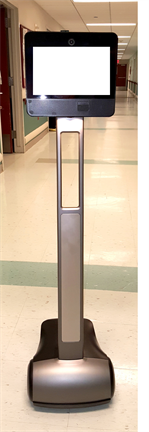Utilizing Telepresence Machines to Assist Patients with Impaired Mobility
 Stephen Erosa, DO
Stephen Erosa, DO
PGY3, Department of Physical Medicine and Rehabilitation, Montefiore Medical Center/NYC Health + Hospitals/Jacobi
 Justin Weppner, DO
Justin Weppner, DO
PGY3, University of Virginia School of Medicine
Telepresence robotics is a sophisticated form of robotic remote control in which a human operator has a sense of being on location—that is, of being telepresent. The telepresence robot, which looks like a monitor attached to a Segway, has new applications in those with disabilities. These telepresence robots help people with impaired mobility see the world. Stephen Erosa, DO, is a resident physician in New York City and believes the Beam telepresence robot can make a big difference throughout the New York City Health + Hospitals system.
 Patients in New York City who have suffered high cervical spinal cord injuries are starting to see the benefits of this technology by utilizing the Beam, which acts as a Skype on wheels. The Beam consists of an LED screen mounted on a self-propelled base; the screen broadcasts the patient’s face, screen-mounted speakers broadcast voice, and a camera and mic mounted on the Beam bring the outside world to the bedside. The beam is controlled through a laptop computer using a modified mouse and an infrared motion sensor attached to the forehead. The sensor interfaces with the computer-based Beam program; the patient’s head movements control the direction of the Beam’s travels, and the mouse acts as an accelerator. The Beam is made even more attractive by the fact that the device is universal. Any patient can use it and the controlling interface is the only component of the technology that may need customization to accommodate the patient’s physical capabilities.
Patients in New York City who have suffered high cervical spinal cord injuries are starting to see the benefits of this technology by utilizing the Beam, which acts as a Skype on wheels. The Beam consists of an LED screen mounted on a self-propelled base; the screen broadcasts the patient’s face, screen-mounted speakers broadcast voice, and a camera and mic mounted on the Beam bring the outside world to the bedside. The beam is controlled through a laptop computer using a modified mouse and an infrared motion sensor attached to the forehead. The sensor interfaces with the computer-based Beam program; the patient’s head movements control the direction of the Beam’s travels, and the mouse acts as an accelerator. The Beam is made even more attractive by the fact that the device is universal. Any patient can use it and the controlling interface is the only component of the technology that may need customization to accommodate the patient’s physical capabilities.
“The patient experience suggests that there is amazing potential for telepresence technology to improve quality of life for the most severely disabled patients. For patients who find even assisted movement extremely unpleasant, the Beam has the promise to afford the sort of experiences that most of us take for granted,” says Erosa.
This technology affords an exciting opportunity for people with impaired mobility to interact with the world to improve their quality of life.
If you would like more information about the technology from one of its first adopters, please visit Robots for Humanity, a non-profit organization supporting this technology and others like it. Robots for Humanity was founded by Henry Evans, who suffered a stroke and uses this device on a daily basis.